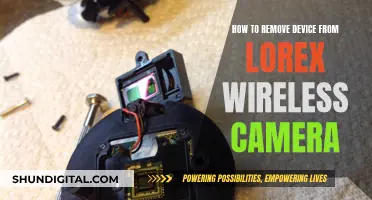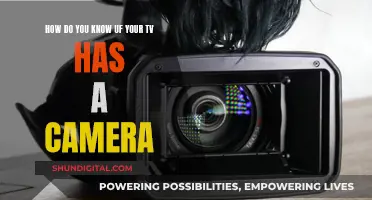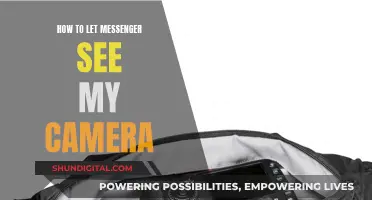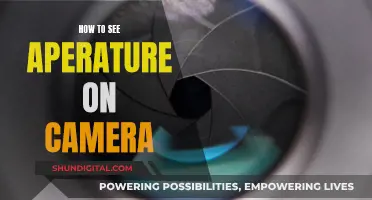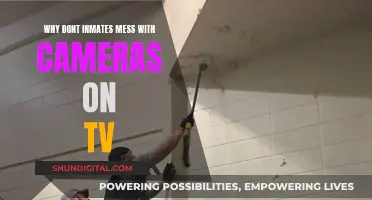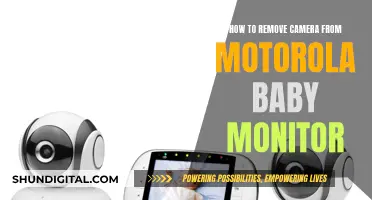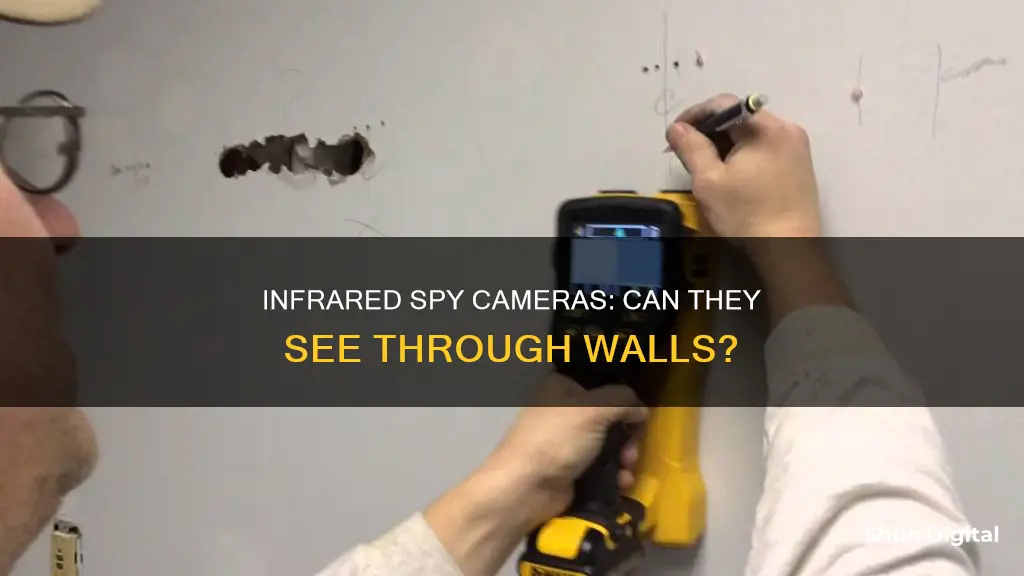
The idea of seeing through walls has long been a fantasy, with people and governments alike trying to develop these capabilities to control people, increase their power, prevent crime, and save lives. While it is not possible to see through walls with the naked eye, certain devices can provide information about what is happening on the other side of a wall. Spy cameras, for example, have been modified to shoot through walls, such as the Soviet Krasnogorsk C166 Nimfa-3 camera, which was designed to be embedded in a wall or ceiling. This camera, however, requires drilling a hole in the wall, which may not always be feasible or discreet. Other technologies, such as infrared light, ultrasonic waves, and radio waves, have also been explored for their potential to see through walls, with varying levels of success. While these technologies have their limitations and ethical considerations, they continue to evolve and advance, making them more accessible and potentially attractive to criminals.
| Characteristics | Values |
|---|---|
| Can spy cameras see through walls? | Yes, but not all. |
| How do they work? | By using infrared light, ultrasonic waves, radio waves, or fiber optics. |
| What are some examples? | The Krasnogorsk C166 Nimfa-3, XaverTM800, and RANGE-R. |
| Are there any limitations? | Yes, radio waves cannot penetrate metal or water, and some materials may distort the signals. |
| What about infrared cameras? | Infrared cameras cannot see through walls, but they can detect heat signatures. |
What You'll Learn
- The Krasnogorsk C166 Nimfa-3 is a Soviet spy camera that shoots through walls
- The Range-R is a radar device used by police to detect people inside a house
- The XaverTM800 is a device that uses 3D imaging to see through walls
- The Stasi, the secret police of East Germany, spied on citizens by drilling holes in walls
- Spy cameras can use infrared light to see in the dark

The Krasnogorsk C166 Nimfa-3 is a Soviet spy camera that shoots through walls
The Krasnogorsk C166 Nimfa-3 is a Soviet spy camera that was designed to shoot through walls. It is a 35mm rangefinder camera, based on the common Soviet Zorki-4 rangefinder, with some modifications to enable its shoot-through-walls capability. The camera was designed to be embedded into a wall or ceiling, with the user drilling a small hole in the wall of the room they wished to spy on, and a larger hole in the adjacent wall to fit the lens through. A peephole-like attachment is then added to the end of the lens, which lines up with the small hole. The lens is described as having a wide-angle field of view, akin to the view through a peephole in a door.
The camera features a reflex-style prism and viewfinder, allowing the user to see what they are shooting, even with a wall blocking their shot. The camera also comes with various extension tubes, enabling the user to spy through walls of different widths. The Krasnogorsk C166 Nimfa-3 was recently up for auction, described as being in "good" and working condition, and "extremely rare". The auction included the original wooden box, a pistol-style grip, and other accessories.
The history of spying and the development of technology to see through walls dates back to the earliest days of civilization. The ability to see through walls has been a long-held fantasy, motivating governments and agencies to invest in its development to control people, increase power, prevent crime, and save lives. The technology has been used by police and military forces for security, surveillance, and reconnaissance.
While the Krasnogorsk C166 Nimfa-3 is a rare example of a camera designed to shoot through walls, other technologies have been developed to achieve this capability. These include the use of infrared light, ultrasonic waves, and radio waves to see through or sense movement behind walls.
Connecting Outdoor Security Cameras to Your TV: A Simple Guide
You may want to see also

The Range-R is a radar device used by police to detect people inside a house
The Range-R is a hand-held radar device used by police to detect people inside a house. It is manufactured by L-3 Communications and is capable of detecting motion through solid walls. The device operates as a finely tuned motion detector, using radio waves to detect the presence of people and movements as small as human breathing. It has an effective range of up to 50 feet and can see through walls, floors, and ceilings constructed of reinforced concrete, cement block, wood, brick, adobe, glass, and other common non-metallic construction materials.
The Range-R provides vital intelligence for law enforcement and search and rescue operations. It is designed for simple one-handed operation and within 3 seconds of activation, the system returns a range-to-target result, as well as the target status (moving or breathing). The device has a conical field of view of 160 degrees and a probability of detection greater than 95%, with a false alarm rate of less than 5%.
The Range-R was the subject of controversy when it was revealed in 2015 that the FBI and U.S. Marshals Service had deployed the devices without public disclosure. Officials stated that the devices were for hostage detection and rescue, but privacy advocates expressed concerns over possible Fourth Amendment abuses. Despite this, the technology is often used in conjunction with other tools such as thermal imaging to provide a more complete picture of what is happening inside a house.
The development of through-wall imaging technology has been an area of interest for governments and law enforcement agencies for several decades. While early methods involved drilling holes in walls or using fiber optics, more advanced systems now utilise radio waves and ultra-wideband (UWB) radars to detect and locate targets on the other side of a wall. The Range-R is an example of a handheld device that employs this technology to provide law enforcement with a powerful tool for gathering intelligence in a variety of situations.
Exploring NVR Systems: Viewing All Cameras
You may want to see also

The XaverTM800 is a device that uses 3D imaging to see through walls
The XaverTM800 is a portable device that uses 3D imaging to see through walls and objects. It is a high-performance system that provides instant and accurate real-time information from behind solid walls or barriers. The device is unique in its ability to provide a true 3D image of objects behind walls.
The XaverTM800 has a range of applications, including military, law enforcement, and search and rescue operations. It is simple to operate and can be carried and used by a single user. The device is ready to use at the push of a button and offers a simple user interface for intuitive interpretation. It has a detection range of up to 20 meters and can detect both static and living objects simultaneously.
One of the key advantages of the XaverTM800 is its ability to provide a clear view of the inside of a room. It can measure the height of objects and track subjects, providing a better understanding of the layout of the area behind the wall. This information is crucial for tactical planning and situational awareness in various operations.
The device is completely radiation-safe and meets the requirements of the ICNIRP-1998 radiation exposure restriction. It is designed with a unique mechanical design and an easy-to-read LCD screen. The XaverTM800 has a battery life of 2 hours and comes with a range of accessories, including a rechargeable battery, external battery charger, power supply, hard-shell carrying case, tripod, and tactical backpack.
Apple Watch Camera: Why Bother?
You may want to see also

The Stasi, the secret police of East Germany, spied on citizens by drilling holes in walls
While it is not possible to see through walls with the naked eye, there are certain devices that can be used to achieve this. These include cameras that use infrared light or ultrasonic waves, as well as devices that use radio waves or radar technology.
During the Cold War, the secret police of East Germany, known as the Stasi, employed a range of surveillance techniques to spy on their citizens. One of their methods involved drilling small holes in walls and inserting special tubes to film citizens through the holes. This technique was used in apartments, hotel rooms, schools, universities, and hospitals. To avoid detection, the Stasi would often take advantage of construction or prevent people from entering their homes while the tubes were being installed.
The Stasi's extensive surveillance network also included the use of hidden cameras disguised as everyday objects, such as arm casts, shopping bags, books, and bras. They also wiretapped, bugged, and tracked citizens, steamed open letters, and had a vast network of informants. The impact of the Stasi's surveillance and control measures had a profound and lasting psychological toll on the citizens of East Germany, even after the fall of the Berlin Wall.
The Krasnogorsk C166 Nimfa-3 is a Soviet spy camera designed to be embedded into a wall or ceiling, allowing users to take photos of the room next door. This camera was modified for snooping and included a reflex-style prism and viewfinder to help the user see what they were shooting. The user would drill a tiny hole in the wall and a larger hole in the adjacent wall for the lens, which had a wide-angle field of view.
Movie Magic: Cameras and Mirrors Secrets
You may want to see also

Spy cameras can use infrared light to see in the dark
While most people would say that spy cameras cannot see through walls, certain types of spy cameras can use infrared light to see in the dark. Infrared (IR) light is invisible to the human eye, but it can be detected by the sensors on smartphone cameras. Spy cameras with IR lighting can be used to capture images in low-light or dark rooms.
IR-equipped spy cameras can be detected by making the room as dark as possible and then using a smartphone camera to slowly scan the room. The IR light will be visible to the smartphone camera, revealing the location of the camera. However, this method is not foolproof, and it may be necessary to purchase a radio frequency (RF) detector to pick up signals from hidden cameras or microphones.
Infrared light is often used in night vision spy cameras, which can record high-quality black and white video in the dark and colour video during the day. These cameras are designed to be discreet and can be hidden in everyday objects such as smoke detectors, oscillating fans, alarm clocks, and even bird feeders. Spy cameras with IR lighting can help improve security and can be used to monitor areas such as a child's bedroom, a living room, or an office.
It is important to note that the use of hidden cameras in private areas or for unethical purposes is illegal in many places. If you suspect that you are being monitored without your consent, you can take steps to detect and report hidden cameras to the authorities.
Stream Your WiFi Camera to TV: Easy Steps to Follow
You may want to see also
Frequently asked questions
Yes, it is possible to see through walls with a spy camera. There are a few different methods that can be used, such as drilling a small hole in the wall and attaching a camera, using a camera that utilises infrared light or ultrasonic waves, or using a radar device such as the RANGE-R.
The RANGE-R is a handheld radar device that has been used by the US police and other government services. It uses radio waves to detect motion inside closed spaces and can detect a person's breathing behind several walls. The RANGE-R costs approximately $6,000.
Spy cameras that can see through walls have several limitations. They cannot penetrate metal or water, and the radio waves are weakened by thick layers of concrete or brick. Additionally, the detection range of most devices is limited to 50-65 feet (about 15-20 meters).


